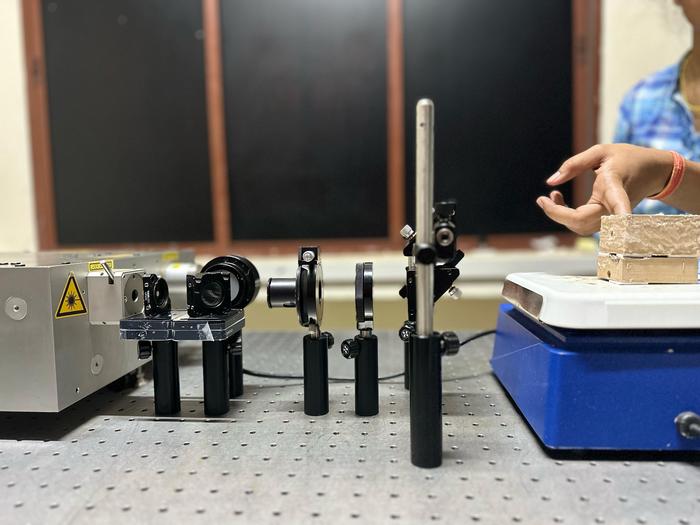The landscape of diabetes management has seen significant advancements, particularly in the realm of blood glucose monitoring. Traditionally, this process relied heavily on invasive methods, primarily involving the frequent pricking of the skin with needles to draw blood for glucose testing. This approach, while effective, presents a logistical challenge for individuals managing diabetes as they are often required to monitor their glucose levels multiple times a day. The resulting discomfort, inconvenience, and potential for infection have always raised questions about the sustainability of such practices.
In light of these challenges, recent research spearheaded by experts from the Department of Instrumentation and Applied Physics (IAP) at the Indian Institute of Science (IISc) provides a promising alternative. Their innovative technique, known as photoacoustic sensing, offers a non-invasive approach to glucose measurement, marking a significant evolution in diabetic self-care. Harnessing the interactions between light and biological tissue, this method transforms how we understand glucose detection.
The process begins when a laser beam is directed onto biological tissue. The interactions that follow are fascinating. As the tissue absorbs the laser light, even a slight increase in temperature occurs, typically less than one degree Celsius. This minute temperature change prompts the tissue to expand and contract, creating vibrations that manifest as ultrasonic sound waves. These waves are subsequently captured by sensitive detectors, revealing critical information about the tissue’s composition without causing any damage.
The team took this foundational concept a step further by specifically targeting glucose measurement. By employing polarised light—light waves oscillating in a single direction—they unlocked a unique characteristic of glucose, a chiral molecule. This characteristic means glucose’s structure can affect how light interacts with it, a property that the researchers exploited to track glucose concentration.
Interestingly, glucose has the ability to rotate the orientation of polarised light. The degree of this rotation bears a direct relationship to the concentration of glucose present. The researchers discovered a correlation between the intensity of the emitted sound waves and the level of glucose present. According to Jaya Prakash, an Assistant Professor at the IAP and the corresponding author of the study published in the esteemed journal "Science Advances," this relationship is profound.
The implications of this research are far-reaching. The team demonstrated that by accurately measuring the intensity of the acoustic signal, they could estimate glucose concentrations with remarkable precision. In their experiments, they not only tested glucose in water but also in serum solutions and even slices of animal tissue. The accuracy of these measurements at varying tissue depths indicates a potential for real-world applications far beyond laboratory settings.
Further diving into the technical intricacies, the researchers explained that sound waves have a unique property—they do not scatter much when traversing through tissue. Given this trait, they could map acoustic signals to their originating depths within the tissue, providing a level of detail that traditional methods simply cannot offer. This advancement suggests a future where continuous glucose monitoring could become both non-invasive and extremely accurate, fundamentally transforming diabetes management.
A compelling pilot study was conducted to showcase the practical application of this technology. During this study, researchers monitored the blood glucose levels of a healthy participant across three days, documenting fluctuations in glucose concentration before and after meals. Swathi Padmanabhan, a PhD student and first author of the paper, revealed the challenges the team faced in creating an effective setup for their experiments. Currently, the laser source they utilized for these measurements is quite specialized, generating small nanosecond pulses that are both expensive and bulky.
This leads to the ongoing pursuit of refining this technology further. As Padmanabhan noted, creating a more compact version of the laser source is paramount for this innovation to transition from the lab to clinical practice. Collaborative efforts in the lab are already underway to streamline this setup for wider applicability in everyday healthcare.
The implications of this technology extend beyond glucose measurement. The researchers are optimistic that this technique can be adapted for a wide array of chiral molecules, simply by altering the wavelength of the light used. In their study, they also succeeded in estimating the concentration of naproxen, a commonly used analgesic, in an ethanol solution, thus highlighting the versatility of their photonic method. With many pharmaceutical drugs exhibiting chiral properties, the potential applications in healthcare and diagnostics are vast and varied.
Overall, the researchers’ findings paint a promising picture for the future of disease management. As healthcare increasingly seeks non-invasive techniques that minimize discomfort while maximizing accuracy, technologies like photoacoustic sensing become crucial. The path they have paved not only addresses the pressing need for easier glucose monitoring for diabetes patients but also opens up avenues for real-time monitoring of various other substances, enhancing the landscape of diagnostics considerably.
The journey from traditional invasive techniques to cutting-edge non-invasive technologies like photoacoustic sensing exemplifies the advancements in biomedical engineering. As the scientific community continues to explore the potential of this innovative method, patient care may soon become more efficient, less invasive, and ultimately more effective, allowing those living with chronic conditions to manage their health with unprecedented ease.
Subject of Research: Non-invasive glucose monitoring using photoacoustic sensing.
Article Title: Deep Tissue Sensing of Chiral Molecules using Polarization Enhanced Photoacoustics.
News Publication Date: 19-Mar-2025.
Web References: Science Advances.
References: N/A.
Image Credits: G Puneeth.
Keywords
Diabetes, non-invasive monitoring, glucose sensing, photoacoustic sensing, polarised light, chiral molecules, biomedical engineering, diagnostics.




